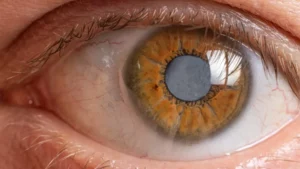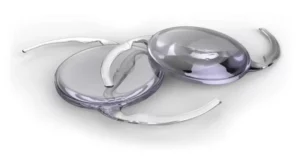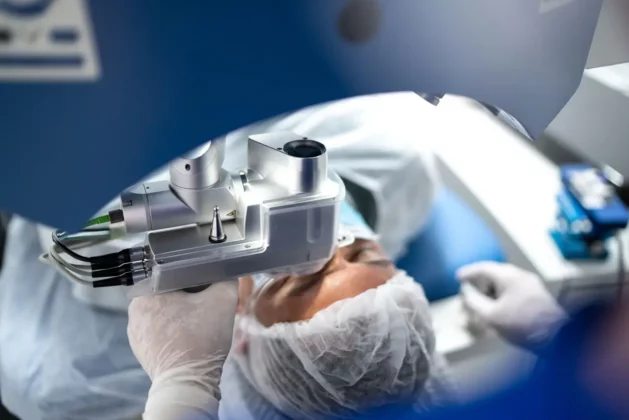If you’re reading this, chances are, you or a loved one is about to embark on a journey towards clearer, brighter vision through cataract surgery. It’s completely natural to have a flurry of questions and maybe a sprinkle of nerves at this juncture. We understand that undergoing any surgery can be a bit daunting, especially when it’s about your precious eyes. But worry not, you’re not alone in this. In the upcoming sections, we shall unfold the entire cataract surgery procedure for you in a simple and digestible manner. From the initial preparations, to the day of the surgery to the nurturing aftercare, we’ve got it all covered for you.
So, sit back, relax, and let us walk you through the path of understanding the cataract surgery procedure from start to finish. Let’s dive right in!
Contents
Understanding the Basics of a Cataract
 Before we delve into the intricacies of the cataract surgery procedure, it’s important to have a fundamental understanding of what a cataract is.
Before we delve into the intricacies of the cataract surgery procedure, it’s important to have a fundamental understanding of what a cataract is.
A cataract refers to the clouding of the naturally clear lens in your eye, often likened to looking through a fogged-up window. This condition generally develops gradually, impairing your vision over time. It’s most commonly seen as a result of aging, although it can occur due to other factors such as injuries, underlying health conditions, or certain medications.
There are several types of cataracts, each characterized by its location and the manner in which they develop in your eye. Here, we will briefly mention the three primary types:
- Nuclear Cataracts: Develops at the center of the lens and often associated with aging.
- Cortical Cataracts: Forms at the outer edge of the lens, characterized by white streaks.
- Posterior Subcapsular Cataracts: Begins at the back of the lens and tends to progress quickly.
Symptoms often vary, but some common signs include blurred vision, difficulty seeing at night, and a heightened sensitivity to light and glare. Understanding these symptoms can help you identify the onset of a cataract and seek timely intervention.
Types of Cataract Surgery to Go For
 Embarking on the journey to regain your clear vision is a crucial step, and understanding the different types of cataract surgery available can be instrumental in making an informed decision. Let’s walk you through the most common types of cataract surgery that you might consider:
Embarking on the journey to regain your clear vision is a crucial step, and understanding the different types of cataract surgery available can be instrumental in making an informed decision. Let’s walk you through the most common types of cataract surgery that you might consider:
- Phacoemulsification (Phaco) This is the most common type of cataract surgery where the surgeon makes a small incision in the eye and uses ultrasound waves to break up the cataract before removing it. It’s known for its quick recovery time and minimal discomfort.
- Extracapsular Cataract Surgery In cases where the cataract is too hard to be broken up by phacoemulsification, this method is used. It involves a larger incision where the cataract is removed in one piece, which means a slightly longer recovery period.
- Femtosecond Laser-Assisted Cataract Surgery This is a more modern approach where a laser is used to make the incisions, break up the cataract, and even correct astigmatism if needed. It offers precision and potentially quicker recovery time, although it might be more expensive than other methods.
- Intracapsular Cataract Surgery Though rarely used today, this method involves removing the entire lens along with the cataract, requiring a larger incision and a much longer recovery time.
It’s important to note that the choice of surgery depends largely on the specific condition of your eye and the recommendation of your eye surgeon. Engaging in a detailed discussion with your healthcare provider will allow you to select the procedure that aligns perfectly with your medical needs and lifestyle preferences.
Before the Surgery: Preoperative Steps
As you edge closer to the date of your cataract surgery, ensuring that you are well-prepared can help make the procedure smoother and stress-free. Let’s navigate through the essential steps you need to take before the surgery:
Consultations and Evaluations
Before embarking on the surgical journey, you will have a series of consultations with your eye specialist. Here, they will:
- Examine Your Eye Health: A thorough examination to assess the current state of your cataracts and the overall health of your eyes.
- Determine the Right IOL (Intraocular Lens): Based on the evaluation, your surgeon will help you choose the appropriate lens implant to suit your vision needs.
Lifestyle Adjustments
To facilitate a seamless surgery and recovery, you might be required to make minor lifestyle adjustments such as:
- Medication Management: Discuss your current medications with your doctor, as you may need to temporarily stop taking certain medicines that can increase the risk of bleeding during surgery.
- Fasting: Usually, you’ll be asked to fast for at least 6 hours before the surgery to prevent any complications.
- Arranging for Transportation: Since you won’t be able to drive yourself home post-surgery, ensure to arrange transportation in advance.
Personal Preparedness
Lastly, remember to cultivate a calm mindset. The prospect of surgery can be daunting, but rest assured that cataract surgeries have high success rates. Embrace the procedure with positivity, looking forward to a future with clearer, brighter vision.
The Day of the Surgery: What to Expect
The day has arrived to take a significant step towards clearer vision. It is only natural to feel a mix of excitement and nervousness. Let’s walk through the process to help you understand exactly what to expect and potentially ease your anxieties.
Arrival and Preparation
- Check-in: Upon your arrival at the hospital or surgical center, you will complete any necessary paperwork and check-in procedures.
- Pre-Surgery Assessment: The medical staff will conduct a final brief assessment to ensure everything is in order.
- Preparation Area: You will be guided to a preparation area where you will be given a gown to wear, and pre-operative medications may be administered to help you relax.
The Procedure
 Before anything else, your comfort is the priority. Anesthesia is administered through eye drops to numb the area, ensuring that you feel no discomfort during the surgery.
Before anything else, your comfort is the priority. Anesthesia is administered through eye drops to numb the area, ensuring that you feel no discomfort during the surgery.
- Step 2: Incision
Once the eye is numb, the surgeon makes a tiny incision on the side of the cornea, the clear front surface of the eye. This incision is precise and minimal, usually requiring no stitches due to its self-sealing nature.
- Step 3: Removal of the Clouded Lens
Through this incision, the surgeon inserts a tiny probe. Using high-frequency ultrasound, the probe breaks the clouded lens (cataract) into small pieces. These pieces are then gently suctioned out of the eye.
- Step 4: Artificial Lens Implant
The next step is the introduction of a new, clear lens. This artificial lens, known as an intraocular lens (IOL), is folded and inserted through the incision. Once inside the eye, it unfolds and takes the position where the natural lens used to be. You will be awake during the surgery, which usually lasts for about 20 to 30 minutes.
- Step 5: Closure
In most cases, the incision is self-sealing, which means stitches are not necessary. However, in some instances, the surgeon might find it prudent to place a suture to ensure the incision is secure.
- Step 6: Recovery
After the procedure is completed, a protective shield or patch may be placed over your eye to prevent any accidental rubbing or pressure. This marks the initiation of the recovery phase, where your eye begins to heal, adapting to its new lens.
Departure
- Going Home: Once the medical team gives the all-clear, you can head home, accompanied by a family member or friend. Remember, it is advised not to drive yourself home after the surgery.
Post-Surgery Care: Ensuring a Smooth Recovery
 Stepping out from the operating room marks the beginning of your journey to rejuvenation. Ensuring a smooth recovery is a vital phase where your role comes into play. Here, we navigate through the essential steps and measures that foster a seamless and safe recuperation.
Stepping out from the operating room marks the beginning of your journey to rejuvenation. Ensuring a smooth recovery is a vital phase where your role comes into play. Here, we navigate through the essential steps and measures that foster a seamless and safe recuperation.
- Follow the Medication Regimen
Right after the surgery, your doctor will prescribe certain medications to prevent infection and reduce inflammation. It is paramount to adhere to the medication schedule meticulously, using eye drops as instructed to facilitate healing.
- Protective Measures
To safeguard your eye from potential irritants and accidental bumps, you’ll be advised to wear a protective shield or eyewear, especially during sleep.
- Activity Restrictions
In the initial stages of recovery, it’s advised to avoid strenuous activities and heavy lifting. Also, it is wise to steer clear of dusty environments to prevent irritation.
- Follow-Up Appointments
Your healing journey will be closely monitored through follow-up appointments. These visits allow your doctor to track the progress of your recovery, making adjustments to your treatment plan as necessary.
- Personal Hygiene
Maintaining hygiene is vital. Washing your hands thoroughly before administering eye drops or touching the area around your eye helps prevent infection.
- Opt for Comfortable and Soothing Environments
As your eye heals, try to stay in environments that are gentle on your eyes. Avoid bright lights and consider using sunglasses to shield your eyes from glare and UV rays.
By adhering to these guidelines, you pave the way for a smooth and successful recovery, stepping closer each day to enjoying the vividness and clarity that life has to offer through your renewed vision.
Frequently Asked Questions
Is the Surgery Painful?
Cataract surgery is generally not painful as before the surgeon begins with procedure, local anesthesia is used to numb the eye area. You might feel slight pressure or a sensation of tugging, but pain is usually minimal or nonexistent.
What is the Recovery Time?
Most people notice a significant improvement in their vision within the first few days after surgery. However, full recovery can take up to a few weeks, during which time it’s important to follow your doctor’s advice on post-surgery care.
Can Cataracts Recur After Surgery?
Once a cataract has been removed, it cannot recur. However, in some cases, the lens capsule that holds the artificial lens can become cloudy over time, a condition called posterior capsule opacification. This can be easily treated with a quick laser procedure.
When Can I Resume Normal Activities?
It generally takes about a week before you can return to your normal activities. However, you should avoid strenuous activities and take necessary precautions as advised by your doctor to protect your eye during the recovery phase.
Will I Need Glasses After Cataract Surgery?
The need for glasses after cataract surgery depends on the type of intraocular lens (IOL) you choose. Some people find that they don’t need glasses for most activities, while others may prefer to wear glasses for reading or other tasks.
What are the Potential Complications?
While complications are rare, they can include infection, inflammation, or retinal detachment. Adhering to post-operative guidelines and maintaining regular follow-ups can help in early detection and management of any potential complications.
Conclusion
Navigating through the intricacies of cataract surgery procedure can indeed seem daunting. But remember, being well-informed is your first step towards a successful journey to a clearer vision. At EyeMantra, we are committed to standing by you at every phase, offering expert guidance and state-of-the-art surgical solutions.
Don’t let the cloudiness blur your zest for life. If you’re experiencing cataract-related problems, we are here to assist you. Cataract Surgery at EyeMantra can usher in a new horizon of clear and vibrant visuals. Don’t delay in securing your visual health. Book your free appointment now at 9711116605.



